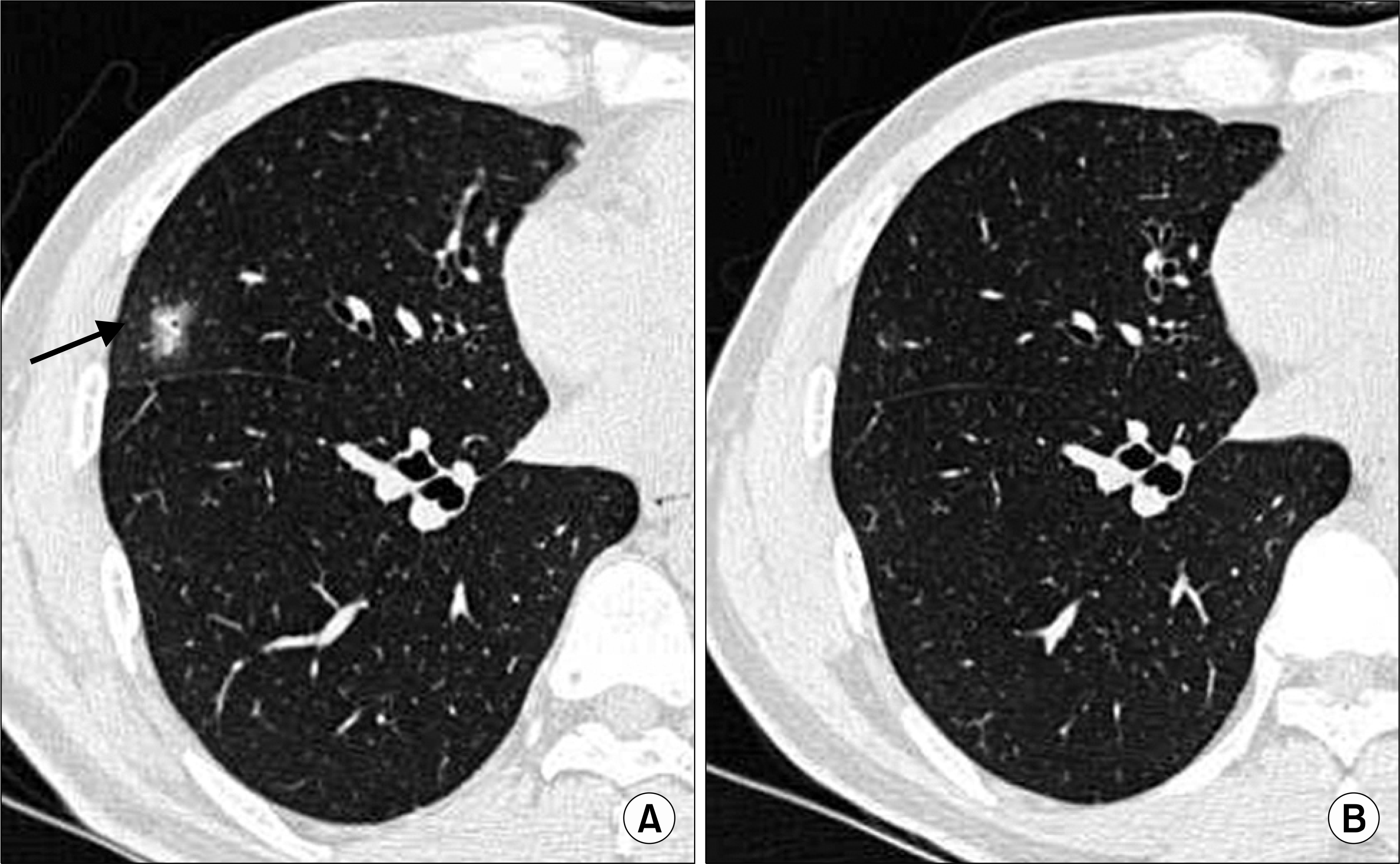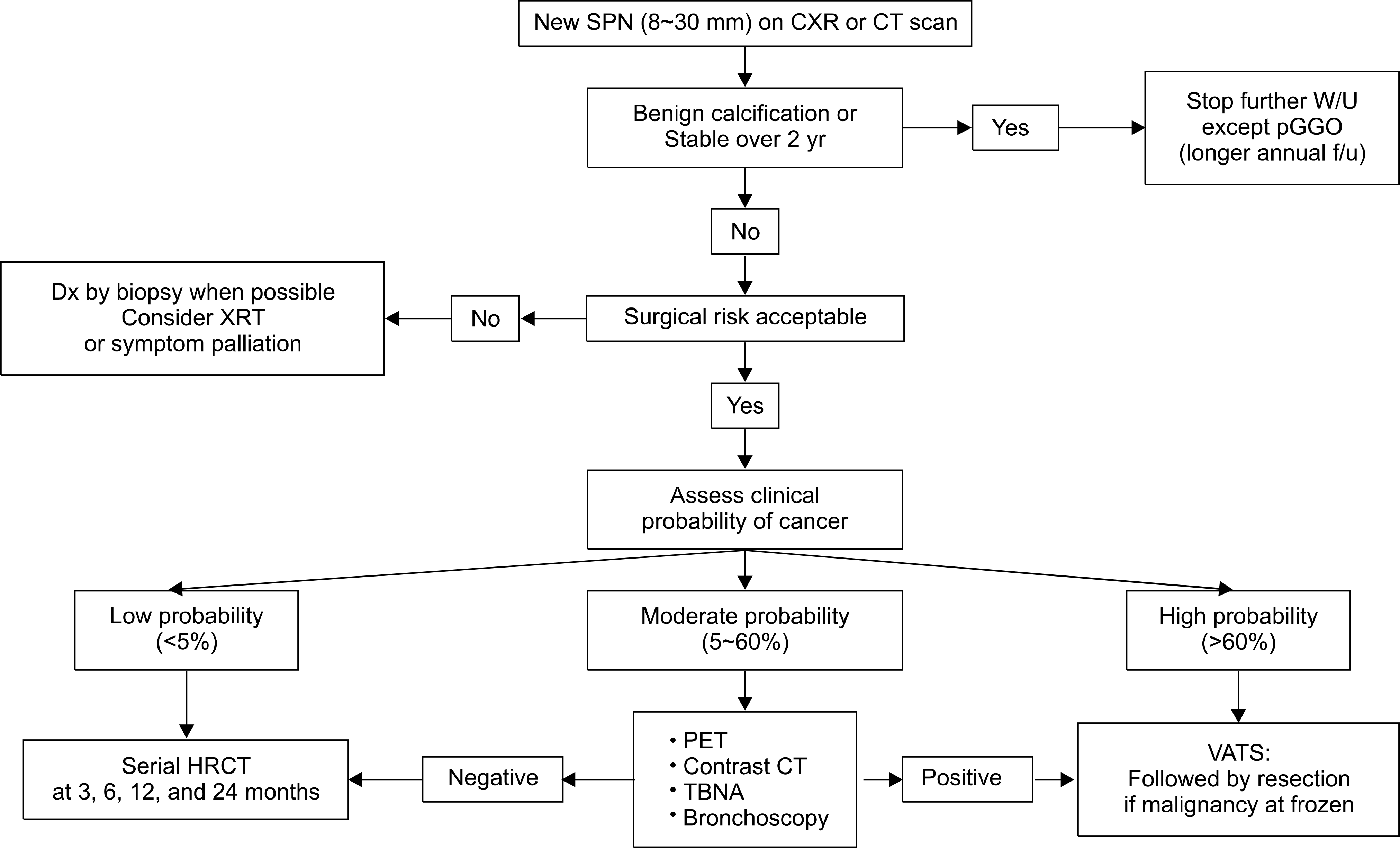Abstract
The introduction of low dose chest computed tomography for health screening in Korea has resulted in increased detection of solitary pulmonary nodules, including nodular ground glass opacity. In contrast to the classic solitary pulmonary nodule, nodular ground glass opacity (GGO) has special characteristics especially in Koreans. More than half of nodular GGOs are transient and they are caused by a pulmonary infiltrate of eosinophils. However, persistent nodular GGO (nGGO) showed a high malignant potential such as atypical adenomatous hyperplasia and bronchioloalveolar cell carcinoma. The increasing use of video assisted thoracoscopic surgery (VATS) for diagnosis and treatment is the current trend for managing nodular GGO. Even though lobectomy is still the standard management for malignant nGGO, limited resection (wide wedge resection or segmentectomy) is widely used for the small malignant GGO (Noguchi types A and B). Multifocal nodular GGOs are mostly of a synchronous origin rather than intrapulmonary metastasis. Therefore, aggressive surgical resection is warranted. This review contains the current concepts for managing nodular GGO and it especially focuses on the Korean data.
Go to : 
References
1. Ost D, Fein AM, Feinsilver SH. Clinical practice. The solitary pulmonary nodule. N Engl J Med. 2003; 348:2535–2542.
2. Austin JH, Muller NL, Friedman PJ, et al. Glossary of terms for CT of the lungs: recommendations of the Nomenclature Committee of the Fleischner Society. Radiology. 1996; 200:327–331.

3. Jang HJ, Lee KS, Kwon OJ, Rhee CH, Shim YM, Han J. Bronchioloalveolar carcinoma: focal area of ground-glass attenuation at thin-section CT as an early sign. Radiology. 1996; 199:485–488.

4. Henscke CI. International early lung cancer action program: enrollment and screening protocol [Internet]. New York: I-ELCAP;2010. Feb 25 [cited 2010 Jun 26]. Available from:. http://www.ielcap.org/professionals/docs/ielcap.pdf.
5. Oh JY, Kwon SY, Yoon HI, et al. Clinical significance of a solitary ground-glass opacity (GGO) lesion of the lung detected by chest CT. Lung Cancer. 2007; 55:67–73.

6. Lee SM, Park CM, Goo JM, et al. Transient part-solid nodules detected at screening thin-section CT for lung cancer: comparison with persistent part-solid nodules. Radiology. 2010; 255:242–251.

7. Yoon YS, Lee CH, Kang YA, et al. Impact of toxocariasis in patients with unexplained patchy pulmonary infiltrate in Korea. J Korean Med Sci. 2009; 24:40–45.

8. Takashima S, Maruyama Y, Hasegawa M, et al. CT findings and progression of small peripheral lung neoplasms having a replacement growth pattern. AJR Am J Roentgenol. 2003; 180:817–826.

9. Hiramatsu M, Inagaki T, Matsui Y, et al. Pulmonary ground-glass opacity (GGO) lesions-large size and a history of lung cancer are risk factors for growth. J Thorac Oncol. 2008; 3:1245–1250.

10. Noguchi M, Morikawa A, Kawasaki M, et al. Small adenocarcinoma of the lung. Histologic characteristics and prognosis. Cancer. 1995; 75:2844–2852.

11. Gandara DR, Aberle D, Lau D, et al. Radiographic imaging of bronchioloalveolar carcinoma: screening, patterns of presentation and response assessment. J Thorac Oncol. 2006; 1(9 Suppl):20S–26S.

12. Godoy MC, Naidich DP. Subsolid pulmonary nodules and the spectrum of peripheral adenocarcinomas of the lung: recommended interim guidelines for assessment and management. Radiology. 2009; 253:606–622.

13. Mitsudomi T, Yatabe Y. Epidermal growth factor receptor in relation to tumor development: EGFR gene and cancer. FEBS J. 2010; 277:301–308.

14. Yatabe Y. EGFR mutations and the terminal respiratory unit. Cancer Metastasis Rev. 2010; 29:23–36.

15. Gould MK, Fletcher J, Iannettoni MD, et al. Evaluation of patients with pulmonary nodules: when is it lung cancer? ACCP evidence-based clinical practice guidelines (2nd edition). Chest. 2007; 132(3 Suppl):108S–130S.
16. Soda H, Nakamura Y, Nakatomi K, et al. Stepwise progression from ground-glass opacity towards invasive adenocarcinoma: longterm follow-up of radiological findings. Lung Cancer. 2008; 60:298–301.

17. Kim TJ, Lee JH, Lee CT, et al. Diagnostic accuracy of CT-guided core biopsy of ground-glass opacity pulmonary lesions. AJR Am J Roentgenol. 2008; 190:234–239.

18. Park CM, Goo JM, Lee HJ, Lee CH, Chun EJ, Im JG. Nodular ground-glass opacity at thin-section CT: histologic correlation and evaluation of change at follow-up. Radiographics. 2007; 27:391–408.

19. Nakata M, Sawada S, Saeki H, et al. Prospective study of thoracoscopic limited resection for ground-glass opacity selected by computed tomography. Ann Thorac Surg. 2003; 75:1601–1605.

20. Yoshida J, Nagai K, Yokose T, et al. Limited resection trial for pulmonary ground-glass opacity nodules: fifty-case experience. J Thorac Cardiovasc Surg. 2005; 129:991–996.

21. Kodama K, Higashiyama M, Takami K, et al. Treatment strategy for patients with small peripheral lung lesion(s): intermediate-term results of prospective study. Eur J Cardiothorac Surg. 2008; 34:1068–1074.

22. Fukui T, Mitsudomi T. Small peripheral lung adenocarcinoma: clinicopathological features and surgical treatment. Surg Today. 2010; 40:191–198.

23. Singhal S, Miller D, Ramalingam S, Sun SY. Gene expression profiling of nonsmall cell lung cancer. Lung Cancer. 2008; 60:313–324.

24. Hou J, Aerts J, den Hamer B, et al. Gene expression-based classification of nonsmall cell lung carcinomas and survival prediction. PLoS One. 2010; 5:e10312.

Go to : 
Figures and Tables
 | Fig. 1.Examples of nodular ground glass opacity (nGGO). (A) Pure nGGO. (B) Mixed nGGO. (C) Mixed nGGO. |
 | Fig. 2.Transient mixed nodular ground glass opacity (nGGO) (toxocariasis). (A) Mixed nGGO with ill-defined border. (B) Complete disappearance of nGGO after 3 months. This patient had a recent history of raw cow liver ingestion and showed blood eosinophilia and positive reaction to toxocara antigen. |
 | Fig. 3.Features of nodular ground glass opacity (nGGO) suggesting malignancy. (A) nGGO with air-bronchogram and pleural retraction. (B) nGGO with air-bronchogram, spiculated border with minimal fissural retraction and (C) nGGO with bubble lucency. |
 | Fig. 4.ACCP Recommended management algorithm for patients with SPN (including nGGO) (8∼30 mm in diameter). SPN: solitary pulmonary nodule, CT: computed tomography, pGGO: pure nodular ground glass opacity, HRCT: high-resolution CT, PET: positron emission tomography, VATS: video assisted thoracoscopic surgery (from Gould MK, et al. Chest 2007;132(3 Suppl):108S–130S, with permission from American College of Chest Physicians) (15). |
Table 1.
Correlation between WHO Classification (2004), Noguchi Classification and Persistent CT GGO Findings (adapted from reference 12 with permission)




 PDF
PDF ePub
ePub Citation
Citation Print
Print


 XML Download
XML Download